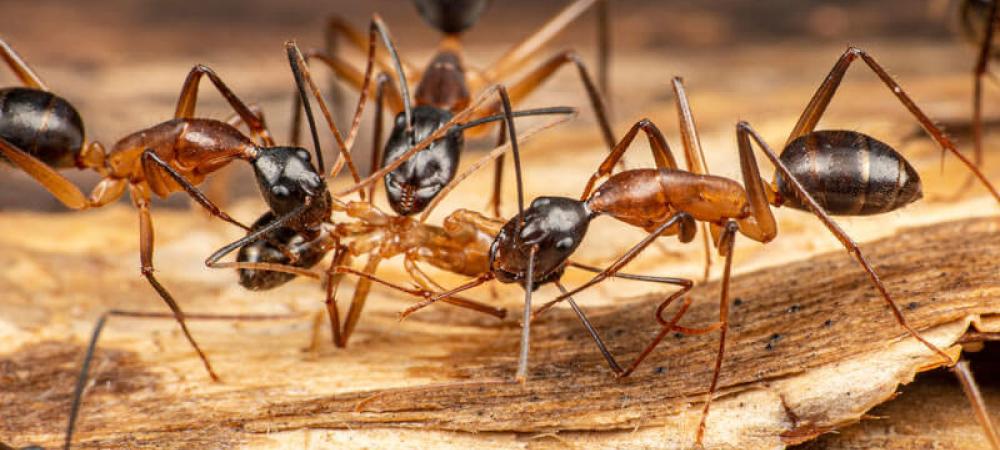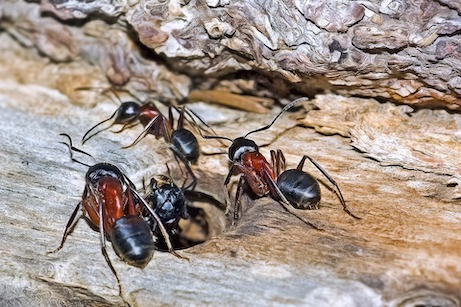Carpenter Ants in Savannah, GA

Savannah, with its warm and humid climate, provides an ideal environment for carpenter ants to thrive. Understanding the dynamics of carpenter ant infestations in this region is crucial for residents looking to protect their homes and structures.
What Are Carpenter Ants?
Carpenter ants are large ants belonging to the genus Camponotus. In Savannah, these industrious insects play a vital role in the local ecosystem by breaking down dead wood. However, when they invade homes and structures, they can become a nuisance and potentially cause damage.
What Do Carpenter Ants Look Like?
Note that the color and size of carpenter ants may vary, but they generally share some distinctive features that set them apart from other ant species. Here are common characteristics of carpenter ants:
- Size: Carpenter ants are among the larger ant species, and their size can range from about 1/4 inch to 3/4 inch (6 to 20 mm) in length. Within a single colony, you may find ants of varying sizes, with major workers being larger than minor workers.
- Color: The color of carpenter ants can vary, but they are typically black, red, brown, or a combination of these colors. Some species may have a reddish or yellowish tint.
- Body Segmentation: Like all insects, carpenter ants have three distinct body segments: head, thorax, and abdomen. Their bodies are divided into these segments, with a noticeable constriction or waist between the thorax and abdomen.
- Antennae: Carpenter ants have elbowed antennae, which means that their antennae have a distinct bend or elbow in the middle. This feature distinguishes them from termites, as termites have straight antennae. Learn more about the difference between ants vs termites.
- Mandibles: Carpenter ants have strong mandibles (jaws) that they use for various tasks, including excavating wood to create nests. The mandibles are typically powerful and adapted for cutting through wood fibers.
- Winged Reproductives: Mature colonies produce winged reproductive individuals, known as swarmers or alates. These winged ants have four wings of equal size, with the front wings being larger than the hind wings. The presence of swarmers may indicate a mature and established carpenter ant colony.
It's important to note that the specific appearance of carpenter ants can vary depending on the species.
Are Carpenter Ants Dangerous?
While carpenter ants do not pose a direct threat to humans, their nesting habits can be damaging to wooden structures. In Savannah, where homes often have wooden components, carpenter ants can cause significant structural damage over time. Identifying the risks and signs of infestation is essential for proactive measures.
What Do Carpenter Ants Eat?
It's important to note that while carpenter ants do not feed on wood, they excavate it to create nests. Their primary source of nutrition comes from external, protein-based food sources, making them opportunistic foragers. They primarily feed on the following common foods:
- Sugars: Carpenter ants are attracted to sugary substances. They may feed on nectar from flowers, honeydew produced by aphids, or other sweet liquids. In households, they are known to forage for sugary foods such as syrups, fruits, and sweets.
- Proteins: Carpenter ants require proteins for their growth and development. They obtain proteins by feeding on other insects, small invertebrates, or even the protein-rich parts of larger insects. They are opportunistic predators, hunting for suitable prey.
- Honeydew: Carpenter ants have a mutualistic relationship with certain honeydew-producing insects, such as aphids. They "farm" these insects for their sweet honeydew excretions. Carpenter ants will protect and tend to aphids, feeding on the honeydew they produce.
- Living or Dead Insects: Carpenter ants are carnivorous and may actively hunt for living or dead insects. They use their strong mandibles to capture and consume other small invertebrates.
- Fruit Juices: Carpenter ants may be attracted to ripe fruits and the juices they produce. In outdoor environments, they may forage on fallen fruits or the sweet juices exuded by damaged or decaying fruit.
In their search of food, carpenter ants may be attracted to food crumbs, spills, and open containers inside your home. Proper sanitation practices, such as keeping food sealed and eliminating food debris, can help deter carpenter ants from foraging indoors.
What Do Carpenter Ant Nests Look Like?
Carpenter ant nests are distinctive structures created by these ants for shelter and reproduction. Here are some characteristics that can help you identify carpenter ant nests:
- Location: Carpenter ant nests are commonly found in damp or decaying wood. They prefer nesting in moist environments, and their colonies can be located in various places, including tree stumps, logs, wooden structures, fence posts, and even within the walls of buildings.
- Gallery System: The interior of a carpenter ant nest consists of a complex network of galleries and tunnels. These galleries serve various purposes, including housing the ant brood (eggs, larvae, pupae), providing shelter for the colony members, and serving as highways for foraging ants.
- Smooth Galleries: Carpenter ants are skilled excavators, and the galleries they create have a smooth, clean appearance. The walls of the galleries are free of mud or soil, distinguishing them from the rough, muddy galleries created by termites. Learn how to recognize signs of a termite infestation.
- Nesting Material: The nesting material for carpenter ants is wood. They typically choose soft or decaying wood, but they can also infest sound wood if it's susceptible to moisture. The ants chew through the wood to create galleries, leaving behind a network of tunnels.
- Satellite Nests: Carpenter ant colonies may have satellite colonies in addition to the main nest. Satellite nests are smaller nests connected to the main colony by foraging trails. These nests contribute to the expansion of the colony and can be located in various sites around the primary nest.
- Moisture Requirements: Carpenter ants are attracted to moisture, so their nests are often associated with damp conditions. Areas with water leaks, high humidity, or poor ventilation are more likely to harbor carpenter ant colonies.
When inspecting for carpenter ant nests, look for signs such as sawdust-like material (known as frass) near nesting sites, hollow sounds when tapping on wood, or the presence of foraging ants. If you suspect a carpenter ant infestation, it's recommended to consult with pest control professionals for a thorough inspection and appropriate control measures.

How To Tell If You Have Carpenter Ants
Identifying whether you have a carpenter ant infestation involves observing specific signs and behaviors associated with these ants. Here are key indicators that can help you determine if you have carpenter ants:
- Frass (Sawdust): Carpenter ants excavate wood to create galleries for nesting. As they tunnel through the wood, they push out sawdust, wood shavings, and debris, creating small piles known as frass. Finding frass near wooden structures, especially in areas with high humidity, may indicate carpenter ant activity.
- Hollowed Wood: Inspect wooden components for signs of hollowed or damaged wood. Carpenter ants create smooth galleries within the wood, weakening its structural integrity. Tap on suspected infested wood, and if it sounds hollow, it could be a sign of carpenter ant activity.
- Trailing Ants: Carpenter ants establish foraging trails between their nests and food sources. If you observe a trail of large ants indoors, particularly near wooden structures, it may signal a carpenter ant infestation. Follow the trail to identify potential nesting sites.
- Audible Nesting Sounds: Carpenter ants can be noisy nesters. If you hear rustling or tapping sounds within walls or wooden structures, it may indicate carpenter ant activity. The sounds can be particularly noticeable during quiet periods, such as at night.
- Presence of Swarmers: Mature carpenter ant colonies produce winged reproductive individuals, known as swarmers or alates. These swarmers emerge during swarming seasons and may be found near the nest. The presence of swarmers is an indication of a well-established parent colony.
- Damaged Insulation: Carpenter ants may use insulation as nesting material, causing damage to insulation within walls. If you notice insulation with signs of disturbance or ants emerging from it, it could indicate a nest nearby.
- Moisture Issues: Carpenter ants are attracted to moisture. Addressing water leaks, high humidity, or damp conditions can help prevent carpenter ant infestations. If you observe ants near sources of moisture, investigate further.
- Distinctive Appearance: Based on the information above, learn to identify carpenter ants based on their distinctive features.
If you observe one or more of these signs, it's advisable to further investigate and, if necessary, seek the assistance of pest control professionals. They can accurately identify the pest, assess the extent of the infestation, and recommend appropriate control measures to address the carpenter ant problem effectively. Early detection and intervention are key to minimizing potential damage to wooden structures.
How To Get Rid of Carpenter Ants
Getting rid of carpenter ants in Savannah requires a comprehensive approach that addresses their nesting habits, foraging behavior, and environmental factors specific to the region's climate. Here are steps to effectively eliminate carpenter ants in Savannah:
- Identify Nesting Sites: Locate and identify carpenter ant nests. Inspect areas with damp or decaying wood, including attics, crawl spaces, and exterior wooden structures.
- Address Moisture Issues: Carpenter ants are drawn to moisture. Ensure proper ventilation, fix leaks promptly, and reduce humidity levels to make your home less attractive to ants.
- Seal Entry Points: Seal cracks, gaps, and openings in the foundation, walls, windows, doors, vents, and utility pipes. Preventing access points reduces the likelihood of new ant colonies establishing themselves.
- Trim Vegetation: Trim tree branches and vegetation that make contact with your home. This minimizes bridges that carpenter ants might use to access your property.
- Remove Attractive Food Sources: Keep food sealed in airtight containers, clean up crumbs and spills promptly, and secure garbage bins. Removing food sources reduces the incentive for ants to forage indoors.
- Use Boric Acid or Diatomaceous Earth: Apply boric acid or diatomaceous earth in areas where ants are active. These substances are effective natural insecticides and can help control ant populations.
- Dust Insecticides: Insecticidal dust can be applied to wall voids and entry points where ants are active. These dusts are effective in reaching hidden nesting areas.
- Insecticidal Baits: Use insecticidal baits designed for carpenter ants. These baits can be placed near ant trails and nest sites, providing an effective means of control.
- Professional Pest Control: Consider hiring a professional pest control service in Savannah. Professionals can accurately identify the scope of the infestation, apply targeted treatments, and provide ongoing monitoring and support.
Professional Ant Exterminators
It's important to tailor your approach based on the specific characteristics of the infestation. If the carpenter ant problem persists or is extensive, seeking professional assistance is advisable for a thorough and effective solution. Look no further than Bee Green Pest Control! With our comprehensive pest treatments, we offer same-day service, a free, detailed home inspection, tailored treatment applications, and effective elimination. Contact our team today to get started!
